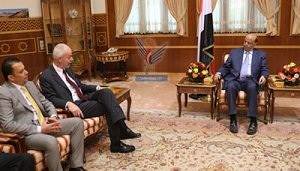Yemen’s Houthi militia claims to have launched an attack on Israel.
Yemen #Yemen

Yemen’s Houthi militia claimed an attempted attack on southern Israel on Tuesday, saying it had launched a “large batch” of ballistic and cruise missiles as well as drones toward Israeli targets.
The Iran-backed militia carried out the attempted assault in response to what it called “brutal Israeli-American aggression” in Gaza, the Houthi military spokesman, Yahya Sarea, said on the social media platform X. Mr. Sarea said the attack was the third operation conducted by the Houthis “in support of our persecuted brothers in Palestine,” and threatened further missile and drone assaults.
The Times could not independently verify the Houthi claims.
On Tuesday, the Israeli military said its aerial defense system had intercepted a surface-to-surface missile fired toward Israel “from the area of the Red Sea.” It said it had also intercepted other “aerial threats” in the area, none of which entered Israeli territory.
The Israeli military did not say who was behind the attacks. But a senior official in the U.S. Department of Defense, speaking on the condition of anonymity, said the Israeli military had intercepted missiles launched from Yemen that had a range of around 1,200 miles.
Yemeni analysts said the attack, despite being thwarted, demonstrated the expanding capabilities of the Houthis, an Iran-backed militia that took over the Yemeni capital, Sana, in 2014. After an unsuccessful attempt by a Saudi-led military coalition to rout it, the group now rules much of northern Yemen. It has also become an important arm of Iran’s so-called “Axis of Resistance,” which includes the Lebanese militia Hezbollah and armed groups in Iraq.
“The Houthis stepping into the battlefield, even in a symbolic manner, sends a clear message to Israel — an unmistakable indication that a new force has emerged against it in the region,” said Ahmed Nagi, a senior Yemen analyst at the International Crisis Group. Diversifying the source of attacks on Israel is a key strategy for the Axis of Resistance that is “designed to confound Israel and deter the broadening of its ground military operations in Gaza,” he said.
Support for the Palestinian cause and hostility toward Israel has long been a pillar of the Houthi narrative. Since the Israeli military began its bombardment of Gaza — responding to the Oct. 7 attacks by Hamas, the Iran-backed armed group that controls Gaza — Houthi leaders have issued repeated threats to enter the fray. Last week, Abdulaziz bin Habtour, prime minister of the Houthi government, said the Houthis might attack Israeli ships in the Red Sea.
In 2015, when the Saudi-led military intervention in Yemen began, the Houthis didn’t even have the capability to carry out drone strikes, said Farea al-Muslimi, a research fellow at Chatham House’s Middle East and North Africa program. But in the years that followed, they built up their capacity, with Iranian support.
Last year, attacks claimed by the Houthis in the capital of the United Arab Emirates, Abu Dhabi — more than 700 miles from northern Yemen — killed three people.
Israel has begun to see the Houthis as a threat in recent years, said Daniel Sobelman, a research fellow at Harvard Kennedy School’s Middle East Initiative who focuses on Iran’s Axis of Resistance. In 2020, Israel deployed Iron Dome batteries near the southern town of Eilat after it assassinated a top Iranian nuclear scientist, “fearing that the retaliation would come from Yemen,” he said.
Even the potential of Houthi attacks on southern Israel means that “Israel must now allocate capabilities that otherwise would have been used elsewhere,” Mr. Sobelman said.
But the extent to which the Houthis present serious risks to Israel is unclear, Mr. Nagi said.
Despite the growth in their military capabilities, the Houthis control a deeply impoverished territory torn apart by war. The Israeli military, in contrast, maintains high-tech air defense systems and is backed by staunch U.S. government support.
That asymmetry also characterized the Houthis’ conflict with Saudi Arabia. Between 2015 and 2021, more than 1,000 missiles and drones launched by the Houthis at Saudi Arabia were largely thwarted, killing around 120 people in total, according to Saudi authorities. By comparison, airstrikes carried out by the Saudi-led coalition in Yemen, many of them by squadrons relying on U.S. support, killed more than 20,000 people, experts estimate.